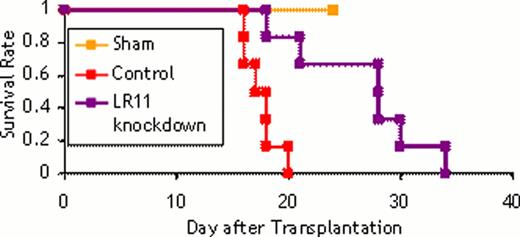Abstract
Abstract 2409
Membrane-anchored uPAR plays a role in regulating the engraftment and mobilization of murine hematopoietic stem/progenitor cells (HSPCs) to bone marrow (BM). Acute myeloid leukemia (AML) patients with higher proportions of uPAR-positive cells posed higher relapse risk after chemotherapy. LR11 (also called SorLA or SORL1) is a regulator of uPAR function through complex formation with uPAR., and the LR11 expression is highly induced in AML cells, and circulating soluble form of LR11 (sLR11) levels are significantly increased in AML patients and ameliorated by chemotherapy (Sakai et al. 2012). Although LR11 is over-expressed in AML, the role of over-expressed LR11 in AML leukemogenesis remains unknown. Recently we found that LR11 mRNA expression levels are drastically increased in murine transformed granulocyte macrophage progenitors (GMPs) with MLL-AF9 fusion gene. Here, we show the pathological significance of LR11 expressions in the progression of AML using mouse leukemia model.
Stably LR11-knockdown (LR11-KD) U937 cells were generated by transfection of shRNA expression vector specific for LR11. For generation of mouse AML model, the GMPs transformed by MLL-AF9 (MA9-GMPs) or human leukemic cells were transplanted into syngeneic mice or immune-deficient mice, respectively. For colony replating assays, MA9-GMPs were cultured in methylcellulose medium and colonies were counted and pooled, and then 1×104 cells were replated in the same medium. For cell growth assays, 5th round MA9-GMPs were transferred to liquid culture. An adhesion assay was performed using human mesenchymal stromal cells (MSC)-coated plates.
U937 cells expressed high level of LR11 mRNA and protein, but there was no difference in cell growth between control and LR11-KD U937 cells in vitro. We transplanted LR11-KD or control U937 cells into recipient mice, and monitored the percent of peripheral blood (PB) leukemia cells by flow cytometry. All the recipient mice transplanted with control U937 cells were died of leukemia by 3 weeks after transplantation, whereas the survival of mice transplanted with LR11-KD U937 cells were prolonged significantly (the median survival: 17.5 days for control cells vs. 28 days for LR11-KD cells, Figure. 1). The percent of leukemia cells in PB of the mice transplanted with LR11-KD U937 cells on day 13 after transplantation were significantly lower than those of mice transplanted with control U937 cells (1.2 ± 1.1% vs. 10.2 ± 5.8%, respectively). We next examined the effect of LR11 on the malignant phenotype by cell growth assay and colony replating assay using the MA9-GMPs from Lr11+/+ and Lr11−/− mice. There was no difference in the cell growth and colony forming ability between Lr11+/+ and Lr11−/− MA9-GMPs. However, the donor chimerism of mice transplanted with Lr11−/− MA9-GMPs was significantly lower than that of mice transplanted with Lr11+/+ MA9-GMPs (the percentage of chimerism on day 28 and on day 35 after transplantation: 54.6 ± 2.1% and 66.3 ± 11.0% for Lr11+/+ donor cells vs. 0.7 ± 2.1% and 0.5 ± 0.1% for Lr11−/− donor cells). We finally examined the cell motility analysis. In the adhesion assay, the attached cell numbers to MSC-coated plates were significantly reduced to 0.7-fold in the LR11-KD U937 cells compared with control U937 cells. In homing assay, we transplanted LR11-KD U937 cells and control cells into recipient mice. The number of LR11-KD U937 cells in recipient BM 16 hours after transplantation was significantly decreased compared with those of control cells (0.011 ± 0.004% for control cells vs. 0.003 ± 0.001% for LR11-KD cells, Figure 2).
These data showed that LR11 plays a critical role in the pathogenesis of AML by enhancing the cell adhesion and homing ability to BM.
Survival of mice transplanted with U937 cells
The role of LR11 on the homing of U937 cells into bone marrow
The role of LR11 on the homing of U937 cells into bone marrow
No relevant conflicts of interest to declare.
Author notes
Asterisk with author names denotes non-ASH members.



This feature is available to Subscribers Only
Sign In or Create an Account Close Modal